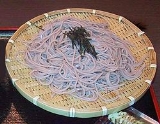
Soba
Encyclopedia
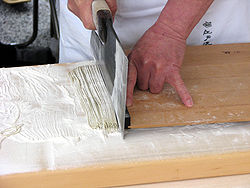
Japanese language
is a language spoken by over 130 million people in Japan and in Japanese emigrant communities. It is a member of the Japonic language family, which has a number of proposed relationships with other languages, none of which has gained wide acceptance among historical linguists .Japanese is an...
name for buckwheat
Buckwheat
Buckwheat refers to a variety of plants in the dicot family Polygonaceae: the Eurasian genus Fagopyrum, the North American genus Eriogonum, and the Northern Hemisphere genus Fallopia. Either of the latter two may be referred to as "wild buckwheat"...
. It is synonymous with a type of thin noodle
Noodle
The noodle is a type of food, made from any of a variety of doughs, formed into long thin ribbons, strips, curly-cues, waves, helices, pipes, tubes, strings, or other various shapes, sometimes folded. They are usually cooked in a mixture of boiling water and/or oil. Depending upon the type, noodles...
made from buckwheat flour
Flour
Flour is a powder which is made by grinding cereal grains, other seeds or roots . It is the main ingredient of bread, which is a staple food for many cultures, making the availability of adequate supplies of flour a major economic and political issue at various times throughout history...
, and in Japan
Japan
Japan is an island nation in East Asia. Located in the Pacific Ocean, it lies to the east of the Sea of Japan, China, North Korea, South Korea and Russia, stretching from the Sea of Okhotsk in the north to the East China Sea and Taiwan in the south...
can refer to any thin noodle (in contrast to thick wheat noodles, known as udon
Udon
is a type of thick wheat-flour noodle of Japanese cuisine.Udon is usually served hot as noodle soup in its simplest form as kake udon, in a mildly flavoured broth called kakejiru which is made of dashi, soy sauce , and mirin. It is usually topped with thinly chopped scallions...
). Soba noodles are served either chilled with a dipping sauce, or in hot broth as a noodle soup
Noodle soup
Noodle soup refers to a variety of soups with noodles and other ingredients served in a light broth. Noodle soup is an East and Southeast Asian staple. Less well known, a form of fresh noodle is used in soup in certain parts of Europe , and in northern China; usually, it is served for breakfast...
. It takes three months for buckwheat to be ready for harvest, so it can be harvested four times a year, mainly in spring, summer, and autumn. In Japan, buckwheat is produced mainly in Hokkaido
Hokkaido
, formerly known as Ezo, Yezo, Yeso, or Yesso, is Japan's second largest island; it is also the largest and northernmost of Japan's 47 prefectural-level subdivisions. The Tsugaru Strait separates Hokkaido from Honshu, although the two islands are connected by the underwater railway Seikan Tunnel...
. Soba that is made with newly-harvested buckwheat is called "shin-soba". It is sweeter and more flavorful than regular soba.
In Japan, soba noodles are served in a variety of settings: they are a popular inexpensive fast food
Fast food
Fast food is the term given to food that can be prepared and served very quickly. While any meal with low preparation time can be considered to be fast food, typically the term refers to food sold in a restaurant or store with preheated or precooked ingredients, and served to the customer in a...
at train station
Train station
A train station, also called a railroad station or railway station and often shortened to just station,"Station" is commonly understood to mean "train station" unless otherwise qualified. This is evident from dictionary entries e.g...
s throughout Japan, but are also served by exclusive and expensive specialty restaurants. Markets sell dried noodles and men-tsuyu, or instant noodle broth, to make home preparation easy.
Some establishments, especially cheaper and more casual ones, may serve both soba and udon as they are often served in a similar manner. However, soba is traditionally the noodle of choice for Tokyoites. This tradition originates from the Tokugawa period, when the population of Edo
Edo
, also romanized as Yedo or Yeddo, is the former name of the Japanese capital Tokyo, and was the seat of power for the Tokugawa shogunate which ruled Japan from 1603 to 1868...
(Tokyo), being considerably wealthier than the rural poor, were more susceptible to beri beri due to their high consumption of white rice, which is low in thiamine
Thiamine
Thiamine or thiamin or vitamin B1 , named as the "thio-vitamine" is a water-soluble vitamin of the B complex. First named aneurin for the detrimental neurological effects if not present in the diet, it was eventually assigned the generic descriptor name vitamin B1. Its phosphate derivatives are...
. It was discovered that beri beri could be prevented by regularly eating thiamine-rich soba. In the Tokugawa era, every neighborhood had one or two soba establishments, many also serving sake, which functioned much like modern cafes where locals would casually drop by for an informal bite to eat.
Serving soba
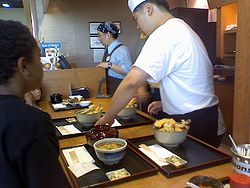
Chopsticks
Chopsticks are small, often tapered, sticks used in pairs of equal length as the traditional eating utensils of China and its diaspora, Japan, Korea, Vietnam and Northern provinces of Laos, Thailand and Burma. Generally believed to have originated in ancient China, they can also be found in some...
, and in Japan
Japan
Japan is an island nation in East Asia. Located in the Pacific Ocean, it lies to the east of the Sea of Japan, China, North Korea, South Korea and Russia, stretching from the Sea of Okhotsk in the north to the East China Sea and Taiwan in the south...
, it is traditionally considered acceptable to slurp the noodles noisily. This is especially common with hot noodles, as drawing up the noodles quickly into the mouth helps cool them down. However, quiet consumption of noodles is no longer uncommon.
Common soba dishes
Like many Japanese noodles, soba noodles are often served drained and chilled in the summer, and hot in the winter with a soy-based dashiDashi
Dashi is a class of soup and cooking stock, considered fundamental to Japanese cooking. In 1980, Shizuo Tsuji wrote: "Many substitutes for dashi are possible, but without dashi, dishes are merely à la japonaise and lack the authentic flavor." Dashi forms the base for miso soup, clear broth, noodle...
broth. Extra toppings can be added onto both hot and cold soba. Toppings are chosen to reflect the seasons and to balance with other ingredients. Most toppings are added without much cooking, although some are deep-fried. Most of these dishes may also be prepared with udon
Udon
is a type of thick wheat-flour noodle of Japanese cuisine.Udon is usually served hot as noodle soup in its simplest form as kake udon, in a mildly flavoured broth called kakejiru which is made of dashi, soy sauce , and mirin. It is usually topped with thinly chopped scallions...
.
Cold soba dishes
Chilled soba is often served on a sieve-like bamboo tray called a zaruZaru
A is a draining basket made from bamboo used in the preparation and presentation of Japanese cuisine. It can be used in a similar fashion to a sieve or colander, both of which are common in western cooking. Additionally, well-designed zaru are used to present food directly, as for example zarusoba...
, sometimes garnished with bits of dried nori
Nori
is the Japanese name for various edible seaweed species of the red alga Porphyra including most notably P. yezoensis and P. tenera, sometimes called laver. Finished products are made by a shredding and rack-drying process that resembles papermaking...
seaweed, with a dipping sauce known as soba tsuyu on the side. The tsuyu is made of a strong mixture of dashi
Dashi
Dashi is a class of soup and cooking stock, considered fundamental to Japanese cooking. In 1980, Shizuo Tsuji wrote: "Many substitutes for dashi are possible, but without dashi, dishes are merely à la japonaise and lack the authentic flavor." Dashi forms the base for miso soup, clear broth, noodle...
, sweetened soy sauce
Soy sauce
Soy sauce is a condiment produced by fermenting soybeans with Aspergillus oryzae or Aspergillus sojae molds, along with water and salt...
(also called "satōjōyu") and mirin
Mirin
is an essential condiment used in Japanese cuisine, consisting of 40%–50% sugar. It is a kind of rice wine similar to sake, but with a lower alcohol content—14% instead of 20%. There are three general types. The first is hon mirin , which contains alcohol. The second is shio mirin, which contains...
. Using chopsticks, the diner picks up a small amount of soba from the tray and swirls it in the cold tsuyu before eating it. Wasabi
Wasabi
, also known as Japanese horseradish, is a member of the Brassicaceae family, which includes cabbages, horseradish, and mustard. Its root is used as a condiment and has an extremely strong flavor. Its hotness is more akin to that of a hot mustard rather than the capsaicin in a chili pepper,...
and scallions are often mixed into the tsuyu. Many people think that the best way to experience the unique texture of hand-made soba noodles is to eat them cold, since letting them soak in hot broth changes their consistency. After the noodles are eaten, many people enjoy drinking the water in which the noodles were cooked (sobayu), mixed with the leftover tsuyu.
- Mori soba : Basic chilled soba noodles served on a flat basket or a plate.
- Zaru soba : Mori soba topped with shredded nori seaweed.
- Hiyashi soba : Cold soba served with various toppings sprinkled on top, after which the broth is poured on by the diner. It may include:
- tororoYam (vegetable)Yam is the common name for some species in the genus Dioscorea . These are perennial herbaceous vines cultivated for the consumption of their starchy tubers in Africa, Asia, Latin America and Oceania...
: puree of yamaimo (a Japanese yam with a mucilaginous texture) - oroshi: grated daikonDaikonDaikon , Raphanus sativus var. longipinnatus, also called White Radish, Japanese radish, Oriental radish, Chinese radish, lo bok and Mooli , is a mild flavoured, very large, white East Asian radish...
radish - nattoNattois a traditional Japanese food made from soybeans fermented with Bacillus subtilis. It is popular especially as a breakfast food. As a rich source of protein and probiotics, nattō and the soybean paste miso formed a vital source of nutrition in feudal Japan. Nattō can be an acquired taste because...
: sticky fermented soybeanSoybeanThe soybean or soya bean is a species of legume native to East Asia, widely grown for its edible bean which has numerous uses...
s - okraOkraOkra is a flowering plant in the mallow family. It is valued for its edible green seed pods. The geographical origin of okra is disputed, with supporters of South Asian, Ethiopian and West African origins...
: fresh sliced okra
- tororo
- Soba maki: Cold soba wrapped in nori and prepared as makizushi.
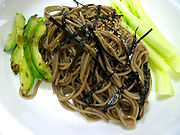
- Soba salad: Cold soba mixed in sesame dressing with vegetables. It is more of a modern and fusion cold soba dish served outside Japan.
Hot soba dishes
Soba is also often served as a noodle soupNoodle soup
Noodle soup refers to a variety of soups with noodles and other ingredients served in a light broth. Noodle soup is an East and Southeast Asian staple. Less well known, a form of fresh noodle is used in soup in certain parts of Europe , and in northern China; usually, it is served for breakfast...
in a bowl of hot tsuyu. The hot tsuyu in this instance is thinner than that used as a dipping sauce for chilled soba. Popular garnishes are sliced scallion and shichimi togarashi (mixed chilli powder).
- Kake soba : Hot soba in broth topped with thinly sliced scallion, and perhaps a slice of kamabokoKamabokois a type of cured surimi, a Japanese processed seafood product, in which various white fish are pureed, combined with additives such as MSG, formed into distinctive loaves, and then steamed until fully cooked and firm. The steamed loaves are then sliced and served unheated with various dipping...
(fish cake). - KitsuneKitsuneis the Japanese word for fox. Foxes are a common subject of Japanese folklore; in English, kitsune refers to them in this context. Stories depict them as intelligent beings and as possessing magical abilities that increase with their age and wisdom. Foremost among these is the ability to assume...
soba ("fox soba", in KantōKanto regionThe is a geographical area of Honshu, the largest island of Japan. The region includes the Greater Tokyo Area and encompasses seven prefectures: Gunma, Tochigi, Ibaraki, Saitama, Tokyo, Chiba, and Kanagawa. Within its boundaries, slightly more than 40 percent of the land area is the Kantō Plain....
) or Tanuki soba ("raccoon soba", in KansaiKansaiThe or the lies in the southern-central region of Japan's main island Honshū. The region includes the prefectures of Mie, Nara, Wakayama, Kyoto, Osaka, Hyōgo, and Shiga. Depending on who makes the distinction, Fukui, Tokushima and even Tottori Prefecture are also included...
): Topped with aburaage (deep-fried tofuTofuis a food made by coagulating soy milk and then pressing the resulting curds into soft white blocks. It is part of East Asian and Southeast Asian cuisine such as Chinese, Japanese, Korean, Indonesian, Vietnamese, and others. There are many different varieties of tofu, including fresh tofu and tofu...
). - SokiSokiis a specialty of the cuisine of Okinawa Prefecture, Japan. Sōki are stewed pork spare ribs, with the cartilage still attached. They are often served with Okinawa soba.-Sōki soba:Okinawa soba with stewed sōki on top...
soba: An Okinawan specialty, topped with soki (stewed pork) - TanukiTanukiis the common Japanese name for the Japanese raccoon dog . They have been part of Japanese folklore since ancient times...
soba (in KantōKanto regionThe is a geographical area of Honshu, the largest island of Japan. The region includes the Greater Tokyo Area and encompasses seven prefectures: Gunma, Tochigi, Ibaraki, Saitama, Tokyo, Chiba, and Kanagawa. Within its boundaries, slightly more than 40 percent of the land area is the Kantō Plain....
) or Haikara soba (in KansaiKansaiThe or the lies in the southern-central region of Japan's main island Honshū. The region includes the prefectures of Mie, Nara, Wakayama, Kyoto, Osaka, Hyōgo, and Shiga. Depending on who makes the distinction, Fukui, Tokushima and even Tottori Prefecture are also included...
): Topped with tenkasuTenkasuare crunchy bits of deep fried flour-batter used in Japanese cuisine, for example in takoyaki, okonomiyaki, and udon. Tenkasu is also called ....
(bits of deep-fried tempuraTempura], is a Japanese dish of seafood or vegetables that have been battered and deep fried.-Batter:A light batter is made of cold water and soft wheat flour . Eggs, baking soda or baking powder, starch, oil, and/or spices may also be added...
batter). - Tempura soba : Topped with tempura, usually a large shrimpShrimpShrimp are swimming, decapod crustaceans classified in the infraorder Caridea, found widely around the world in both fresh and salt water. Adult shrimp are filter feeding benthic animals living close to the bottom. They can live in schools and can swim rapidly backwards. Shrimp are an important...
. - TsukimiTsukimior Otsukimi, literally moon-viewing, refers to Japanese festivals honoring the autumn moon. The celebration of the full moon typically takes place on the 15th day of the eighth month of the traditional Japanese lunisolar calendar; the waxing moon is celebrated on the 13th day of the ninth month...
soba ("moon-viewing soba"): Topped with raw egg, which poaches in the hot soup. - Tororo soba or Yamakake soba : Topped with tororoDioscorea oppositaDioscorea opposita is a type of yam that may be eaten raw....
, the puree of yamaimoDioscorea oppositaDioscorea opposita is a type of yam that may be eaten raw....
(a potato-like vegetable with a mucilaginous texture). - Wakame soba : Topped with wakameWakame, Undaria pinnatifida, or Miyeok in Korean, is a sea vegetable, or edible seaweed. It has a subtly sweet flavour and is most often served in soups and salads....
seaweed - Soba-yu : This is warm water that boiled soba, much like broth. People drink dipping sauce mixed with soba-yu to enjoy the flavor of soba; however, there is little or no nutritional value.
- Nameko soba : Topped with nameko mushroom
- Sansai soba ("mountain vegetables soba"): Topped with sansaiSansaiis a Japanese word literally meaning "mountain vegetables", originally referring to vegetables that grew naturally in the wild and were not cultivated. However in modern times, the distinction is somewhat blurred, as some sansai such as warabi have been successfully cultivated...
, or wild vegetables such as warabiBrackenBracken are several species of large, coarse ferns of the genus Pteridium. Ferns are vascular plants that have alternating generations, large plants that produce spores and small plants that produce sex cells . Brackens are in the family Dennstaedtiaceae, which are noted for their large, highly...
, zenmai and takenoko (bamboo shoots). - Kamonanban : Topped with duck meat and negi.
- Currynanban : Hot soba in curry flavored broth topped with chicken/pork and thinly sliced scallion.
- Nishin soba : Topped with migaki nishin , or dried fish of the Pacific herringPacific herringThe Pacific herring, Clupea pallasii, is a species of the herring family associated with the Pacific Ocean environment of North America and northeast Asia. This species is a silvery fish with unspined fins and a deeply forked caudal fin...
.
Soba served on special occasions
Soba is traditionally eaten on New Years Eve in most areas of Japan, a tradition that survives to this day: Toshikoshi soba. In the TokyoTokyo
, ; officially , is one of the 47 prefectures of Japan. Tokyo is the capital of Japan, the center of the Greater Tokyo Area, and the largest metropolitan area of Japan. It is the seat of the Japanese government and the Imperial Palace, and the home of the Japanese Imperial Family...
area, there is also a tradition of giving out soba to new neighbours after a house move (Hikkoshi soba), although this practice is now rare.
Nutrition of soba
100 grams of soba yields 344 kcal (1,439,296 J) of energy. Soba contains all eight essential amino acids, including lysineLysine
Lysine is an α-amino acid with the chemical formula HO2CCH4NH2. It is an essential amino acid, which means that the human body cannot synthesize it. Its codons are AAA and AAG....
, which is lacking in wheat.
Soba contains a type of polysaccharide
Polysaccharide
Polysaccharides are long carbohydrate molecules, of repeated monomer units joined together by glycosidic bonds. They range in structure from linear to highly branched. Polysaccharides are often quite heterogeneous, containing slight modifications of the repeating unit. Depending on the structure,...
that is easily digested. Soba noodles also contain antioxidants, including rutin
Rutin
Rutin, also called rutoside, quercetin-3-O-rutinoside and sophorin, is a citrus flavonoid glycoside found in buckwheat, the leaves and petioles of Rheum species, and asparagus...
and quercetin
Quercetin
Quercetin , a flavonol, is a plant-derived flavonoid found in fruits, vegetables, leaves and grains. It also may be used as an ingredient in supplements, beverages or foods.-Occurrence:...
, and essential nutrients including choline
Choline
Choline is a water-soluble essential nutrient. It is usually grouped within the B-complex vitamins. Choline generally refers to the various quaternary ammonium salts containing the N,N,N-trimethylethanolammonium cation....
, thiamine
Thiamine
Thiamine or thiamin or vitamin B1 , named as the "thio-vitamine" is a water-soluble vitamin of the B complex. First named aneurin for the detrimental neurological effects if not present in the diet, it was eventually assigned the generic descriptor name vitamin B1. Its phosphate derivatives are...
and riboflavin
Riboflavin
Riboflavin, also known as vitamin B2 or additive E101, is an easily absorbed micronutrient with a key role in maintaining health in humans and animals. It is the central component of the cofactors FAD and FMN, and is therefore required by all flavoproteins. As such, vitamin B2 is required for a...
.
Varieties of soba noodles
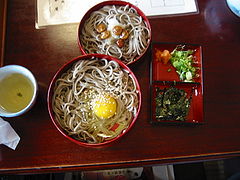
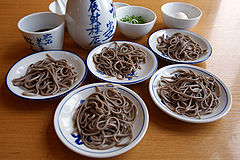
Nagano Prefecture
is a prefecture of Japan located in the Chūbu region of the island of Honshū. The capital is the city of Nagano.- History :Nagano was formerly known as the province of Shinano...
. Soba from Nagano is called Shinano Soba or Shinshu soba. Ni-hachi (二八, two-eight) soba, consists of two parts of wheat and eight of buckwheat; Juuwari (十割, 100%) soba, the finest (and usually most expensive) variety, consists entirely of buckwheat.
- Sarashina soba: thin, light-colored soba, made with refined buckwheat
- Inaka soba: "country soba", thick soba made with whole buckwheat
By location
- Shinshu soba: named after the old name of Nagano PrefectureNagano Prefectureis a prefecture of Japan located in the Chūbu region of the island of Honshū. The capital is the city of Nagano.- History :Nagano was formerly known as the province of Shinano...
. Also known as Shinano soba. (Shinano=Shinshu) - Etanbetsu soba: named after the central region of HokkaidōHokkaido, formerly known as Ezo, Yezo, Yeso, or Yesso, is Japan's second largest island; it is also the largest and northernmost of Japan's 47 prefectural-level subdivisions. The Tsugaru Strait separates Hokkaido from Honshu, although the two islands are connected by the underwater railway Seikan Tunnel...
(Asahikawacity) - Izumo soba: named after IzumoIzumo, Shimaneis a city located in Shimane, Japan. Izumo is known for Izumo soba noodles and the Izumo Taisha Shinto shrine.-Demographics:The modern city was founded on November 3, 1941....
in ShimaneShimane Prefectureis a prefecture of Japan located in the Chūgoku region on Honshū island. The capital is Matsue. It is the second least populous prefecture in Japan, after its eastern neighbor Tottori. The prefecture has an area elongated from east to west facing the Chūgoku Mountain Range on the south side and to... - Izushi soba: named after IzushiIzushi, Hyogowas a town located in the former Izushi District, Hyōgo, Japan.On April 1, 2005 Izushi, along with the towns of Kinosaki, Hidaka and Takeno, all from Kinosaki District, and the town of Tantō, also from Izushi District, was merged into the expanded city of Toyooka and no longer exists as an...
in HyōgoHyogo Prefectureis a prefecture of Japan located in the Kansai region on Honshū island. The capital is Kobe.The prefecture's name was previously alternately spelled as Hiogo.- History :...
By ingredients
- JinenjoDioscorea oppositaDioscorea opposita is a type of yam that may be eaten raw....
soba: flavored with wild yam flour - Cha soba: flavored with green teaGreen teaGreen tea is made solely from the leaves of Camellia sinensis that have undergone minimal oxidation during processing. Green tea originates from China and has become associated with many cultures throughout Asia. It has recently become more widespread in the West, where black tea is traditionally...
powder - Mugi soba: flavored with mugwort
- Hegi soba: flavored with seaweed
- Ni-hachi soba: soba containing 20% wheat and 80% buckwheat
- Towari soba or Juwari soba: 100% buckwheat soba
Other uses of the word soba
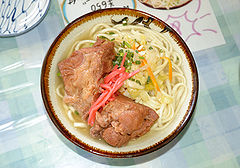
Tea
Tea is an aromatic beverage prepared by adding cured leaves of the Camellia sinensis plant to hot water. The term also refers to the plant itself. After water, tea is the most widely consumed beverage in the world...
called sobacha, which may be served hot or cold. Buckwheat hulls, or sobakawa (also called sobagara), are used to fill pillows. Sometimes, beers are made with roasted buckwheat added as a flavoring, and called "soba ale."
Soba is occasionally used to refer to noodles in general. In Japan, ramen
Ramen
is a Japanese noodle dish. It consists of Chinese-style wheat noodles served in a meat- or fish-based broth, often flavored with soy sauce or miso, and uses toppings such as , , kamaboko, green onions, and occasionally corn...
is sometimes called chūka soba or shina soba (both mean Chinese
China
Chinese civilization may refer to:* China for more general discussion of the country.* Chinese culture* Greater China, the transnational community of ethnic Chinese.* History of China* Sinosphere, the area historically affected by Chinese culture...
noodles). Parboiled chūka soba is stir-fried to make yakisoba
Yakisoba
', literally "fried noodles", is a dish often sold at festivals in Japan, but originates in China. The dish was derived by the Chinese from the traditional chow mein, but has been more heavily integrated into Japanese cuisine like ramen...
. Note that these noodles do not contain buckwheat.
In Okinawa
Okinawa Prefecture
is one of Japan's southern prefectures. It consists of hundreds of the Ryukyu Islands in a chain over long, which extends southwest from Kyūshū to Taiwan. Okinawa's capital, Naha, is located in the southern part of Okinawa Island...
, soba usually refers to Okinawa soba
Okinawa soba
is a type of noodle soup eaten in Okinawa. In Okinawa, it is sometimes simply called soba or suba, although it is different from buckwheat noodles known as soba in the rest of Japan...
, a completely different dish of noodles made out of flour, not buckwheat. Okinawa soba is also quite popular in the city of Campo Grande
Campo Grande
-Climate:Campo Grande has a highland tropical climate, semi-humid, hot, and notably seasonal, with a dry winter season from May through September or October. Under the Koppen climate classification Campo Grande features a tropical wet and dry climate, albeit a noticeably cooler version of the...
(Brazil
Brazil
Brazil , officially the Federative Republic of Brazil , is the largest country in South America. It is the world's fifth largest country, both by geographical area and by population with over 192 million people...
), due to influence of Japan
Japan
Japan is an island nation in East Asia. Located in the Pacific Ocean, it lies to the east of the Sea of Japan, China, North Korea, South Korea and Russia, stretching from the Sea of Okhotsk in the north to the East China Sea and Taiwan in the south...
ese (Okinawan) immigrants. It is eaten at street markets or in special restaurants called "sobarias".
External links
- Tokyo soba chef making noodles by hand from scratch—illustrated article in English
- Soba restaurant owner in Nagano making soba noodles—slide show with English subtitles

